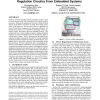Free Online Productivity Tools
i2Speak
i2Symbol
i2OCR
iTex2Img
iWeb2Print
iWeb2Shot
i2Type
iPdf2Split
iPdf2Merge
i2Bopomofo
i2Arabic
i2Style
i2Image
i2PDF
iLatex2Rtf
Sci2ools
CODES
2007
IEEE
2007
IEEE
Power deregulation: eliminating off-chip voltage regulation circuitry from embedded systems
In battery-powered embedded systems, dedicated circuitry is used to convert stored energy into a form that can be directly used by processors. These power regulation devices seek to mask non-ideal aspects of the battery and present an ideal, fixed-voltage power source to the processor. However, this comes at a high price in terms of form factor, component cost, and energy efficiency. We describe and evaluate a new method for eliminating voltage regulation circuitry from battery-powered embedded systems. This method makes use of power gating, frequency scaling, and thread migration in chip-level multiprocessors to dynamically adjust to varying battery voltage. The key advantages of this approach are reduction in printed circuit board area (by 1/3 in many embedded applications) and the elimination of bulky unreliable discrete components such as electrolytic capacitors while maintaining similar battery lifespan. We have evaluated the power consumption, performance, and reliability impl...
Battery-powered Embedded Systems | CODES 2007 | Hardware-Software Codesign | Power Regulation | Regulation Circuitry |
| Added | 02 Jun 2010 |
| Updated | 02 Jun 2010 |
| Type | Conference |
| Year | 2007 |
| Where | CODES |
| Authors | Seunghoon Kim, Robert P. Dick, Russ Joseph |
Comments (0)

